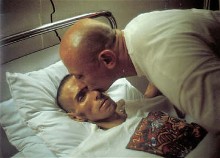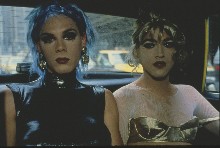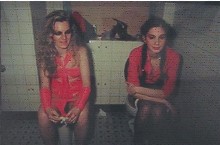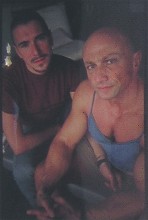
The shock that accompanied my first Nan Goldin experience from maybe 25 or 30 years ago is gone (image, “Gotscho Kissing Gilles, Paris 1993).
A selection of works from a private collection, about 27 images in all (unless you count the triptych grid of images as three–or even 27 images) of mostly cibachrome prints are on exhibit at the Morris Gallery at the Pennsylvania Academy of the Fine Arts, in an exhibit called “Fantastic Tales.”
With really only one shocking (to me) image in the show, arguably two, I had to pay attention to just what Goldin is doing and decide whether I cared.
I do care.

I left the show with an overwhelming sadness while a reel of “Is That All There is?” played in my head. I had had a confrontation with death and life and what really matters.
Not snapshots
Although the photos have a snapshot pedigree, they are not snapshots at all. Think about people in snapshots. They are grinning. They are preening. They are showing their public faces, their moments of triumph, their experiences of unbridled glee.
Goldin’s best photos show the non-public, non-posed moments, the times of acute intimacy, of emotional and sometimes physical nudity. She captures the connection between people, the desperate hunt for that connection, the unselfconscious and vulnerable moment.

In “Misty and Jimmy Paulette in a Taxi, NYC” the juice of the photo is in the unposed reflectiveness, the two subjects all ready for the parade in their dresses, but not self-conscious, not yet performing. The contrast betweeen the performance and the non-performance, the high-energy posturing and the moment of stillness is acute here (image, “Misty and Jimmy Paulette in a Taxi, NYC 1991”).
The milieu is Goldin’s own bohemian lifestyle, but its when she reaches beneath the raunchy style and gets to humanity, identity and mortality that the work sings loudest. It’s the point where men are no longer men but human beings, and where women are no longer women, but human beings, with an unflinching view of their most physical or most emotional.
I have to wonder just how she is able to reach that point where people unmask themselves to her at their most intimate moments. (I wonder the same thing about Zoe Strauss’ work, and Zoe achieves this with complete strangers and with not a hint of self-absorption. Strauss is also an heir to the Goldin ever-mutating slide show with music back-up).
Distances bridged

Sometimes it seems clear that drugs play a part, as in “Cookie and Millie in the Girls’ room at the Mudd Club.” The two of them, sitting on neighboring cans, their panties down, must be totally whiffed, but they are caught laughing and having a good ol’ time. It’s only the unlikelihood of a photographer gaining access that makes this more than a snapshot (image, “Cookie and Millie in the Girls’ room at the Mudd Club 1979”).
By now, when we’re all snapping and videotaping away, that photo seems almost quaint. Without the program notes, the hindsight of Cookie’s death from AIDS adding a shadow of mortality to this moment of high-jinx intimacy, the picture may lose some of its snap.
But most of us, with our snapping and our videotaping, are creating distance between ourselves and our own experiences. Not so Goldin, who is capturing the selves and the experiences raw, with her nose in the soup of life.
Her choice of medium, cibachrome prints, fits her desire to see clearly, without lies. Besides, it sure makes those patches of red or blue snap, becoming classical drapes–funny reminders of paintings of saints and the Virgin.

AIDS brings a confrontation with mortality to the two photos of Gilles and Gotscho, one showing Gilles as handsome and healthy-looking, the other (at the top of post), a year later, showing him gaunt and ill, a shocking transformation in not a lot of time. It’s the intimacy caught between the two men, however, that makes both of these pictures magical, their sexy relaxed intimacy in the earlier picture, their devotion when mortality has robbed them of the physical glory (image, “Gilles and Gotscho at home,” Paris 1992).
No clothes, no pose
But the confrontation with mortality comes through without AIDS. The unsparing nude of a lover, impassioned lovemaking, hand in the panties, serve as reminders of how vulnerable we are without our clothes or without our pose.
At one point, I wondered about the similarities and differences of Goldin compared to Elizabeth Peyton. But Goldin’s subjects, although they may sometimes look vacant, are not posing at vacancy. They are not making a bourgeois fashion statement.

One of Goldin’s photos, “Nan and Brian in Bed, NYC,” shows Goldin looking incredibly sad and longing. According to the notes on the wall, her relationship was going down the tubes. The photo seemed to me to serve as a synechdoche for all the photos exhibited, all trying to capture what it means to feel and to let it show (image, “Nan and Brian in bed, NYC 1983”).
A talk on Goldin’s theatricality (isn’t this the opposite of what I was just saying?) by Jonathan Weinberg is coming up Jan. 25 at noon in Hamilton Auditorium at PAFA. Weinberg wrote the catalog essay for the show, which was organized by the Palmer Museum of Art at Penn State, University Park, from the collection of Gerry and David Pincus.









